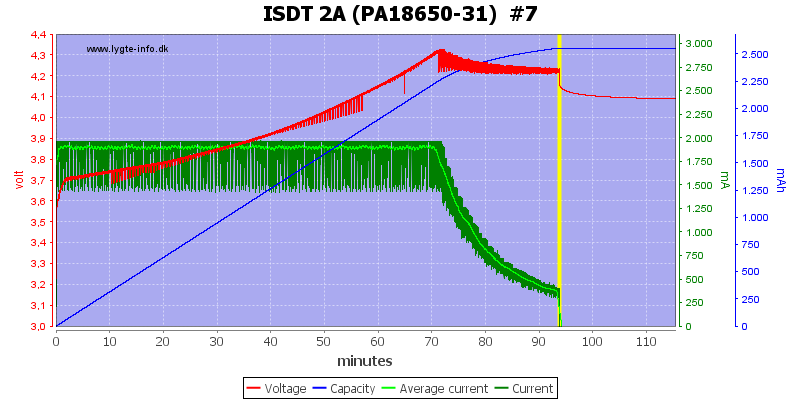AA Cycler
Newly Enlightened
- Joined
- Nov 6, 2016
- Messages
- 55
The conventional wisdom says charge LiIon with CCCV and NiMH with -dV. But how bad CCCV charging is for NiMH cells?
Hard to say so I started a CCCV Charging of NiMH Cells test. The results are not conclusive yet, I am getting too wildly different data on my 2 test cells. I will add a 3rd "confirmation" cell to get more conclusive results. Anyway, I can already conclude what I expected - the cells charge to lower capacity, but last longer (more cycles). I will provide more data once I finish the test.
There is a slight problem with this test though. There are no analyzing NiMH chargers with CCCV. The closes I got is the SkyRC MC3000 charger configured for RAM chemistry. It uses CCCV on Von (I wish it was Voff, see my "improved" CCCV algorithm below) therefor it is slow. And it uses pulsed charge: 7sec on, 3sec off (basically 70% duty cycle) therefor it is slow...
The closes I got is the SkyRC MC3000 charger configured for RAM chemistry. It uses CCCV on Von (I wish it was Voff, see my "improved" CCCV algorithm below) therefor it is slow. And it uses pulsed charge: 7sec on, 3sec off (basically 70% duty cycle) therefor it is slow...
My "improved" CCCV algorithm would monitor 2 voltage levels
The algorithm would look like this:
Could anybody reprogram the firmware of an existing NiMH analyzer and put this algorithm in? I would buy 2 such analyzers
Anybody?
Cheers,
AA Cycler
Hard to say so I started a CCCV Charging of NiMH Cells test. The results are not conclusive yet, I am getting too wildly different data on my 2 test cells. I will add a 3rd "confirmation" cell to get more conclusive results. Anyway, I can already conclude what I expected - the cells charge to lower capacity, but last longer (more cycles). I will provide more data once I finish the test.
There is a slight problem with this test though. There are no analyzing NiMH chargers with CCCV.
My "improved" CCCV algorithm would monitor 2 voltage levels
- Voff voltage with charge current off (open circuit) for the CV phase
- Von voltage with charge current on for overheating protection
The algorithm would look like this:
- start the CC phase with 0.5C charge current (1000mA for AA, 400mA for AAA)
- keep lowering the current to keep Von at max 1.70V
- keep lowering the current to keep Voff at max 1.45V
- stop when the current drops below 10% (100mA for AA, 40mA for AAA)
Could anybody reprogram the firmware of an existing NiMH analyzer and put this algorithm in? I would buy 2 such analyzers
Anybody?
Cheers,
AA Cycler
Last edited:



